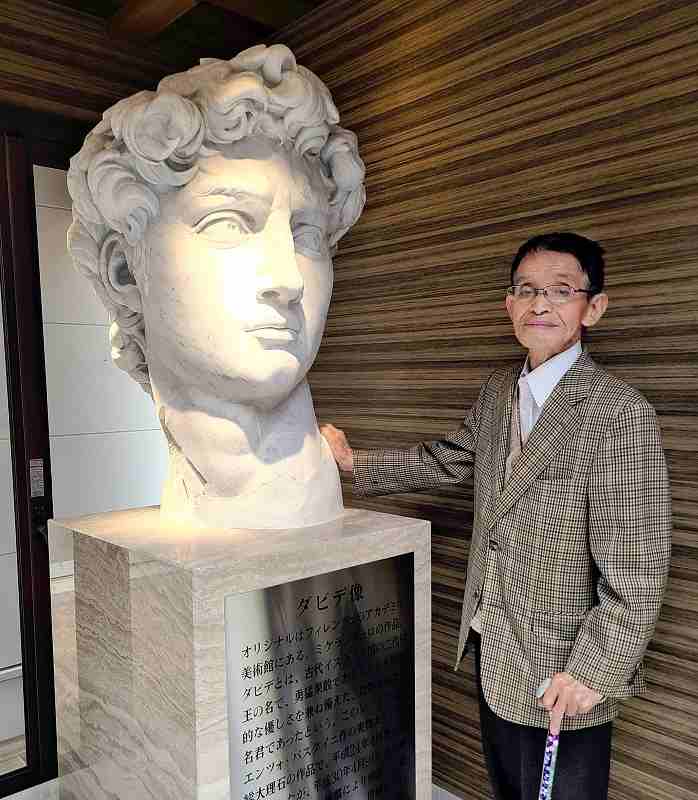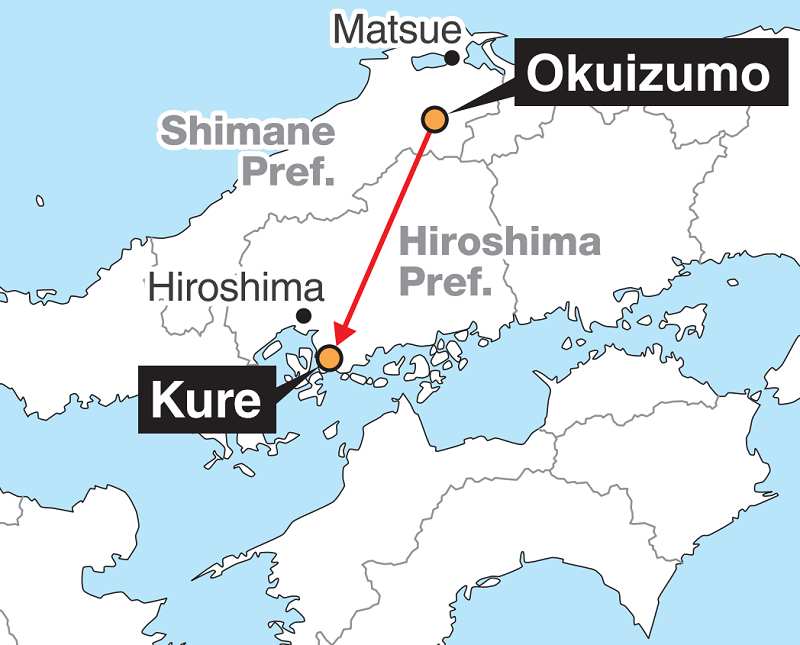
Kazuo Wakatsuki stands by the head of his David statue in Kure, Hiroshima Prefecture.
9:02 JST, June 19, 2021
KURE, Hiroshima/OKUIZUMO, Shimane — A controversial replica of Michelangelo’s David has been resurrected as an unlikely symbol of hope in a small town in Shimane Prefecture, after narrowly surviving both a public obscenity scandal and an earthquake that left the once-towering statue shattered in hundreds of pieces.
Created by the late Italian sculptor Enzo Pasquini in imitation of Renaissance master Michelangelo’s famed David, the ill-fated statute first found its way to Okuizumo, Shimane Prefecture in April 2012.
Kazuo Wakatsuki, honorary chairman of a plastering company in Hiroshima, purchased David along with a replica of the ancient Greek “Venus de Milo,” and donated the statues to Okuizumo as a way of giving back to his hometown.
Upon receiving the generous donation, the town government happily displayed Venus in an amusement park and installed David, measuring five meters tall even excluding his pedestal, in Minari Sports Park.
But it turned out not everyone was pleased by the arrival of the statues. Soon, the town began receiving complaints from residents: “Make him wear underpants; I never know where to look when I walk by,” they blushed. A local assembly member worried aloud at a meeting that the statue was setting an inappropriate example for the town’s children, some of whom reportedly skittered past the statue in revulsion and fright.
The town’s then mayor brushed away the criticism, insisting that first-rate art was precisely what the public needed to cultivate their aesthetic sensitivities. “[The statue’s] at home in the surrounding landscape and we have no intention of moving it,” the mayor said at the time.
The standoff escalated into a full-fledged feud dividing the townspeople into two camps: Art or disgrace? The controversy even went on to raise international eyebrows, after being reported on by the Agence France-Presse.
As the years passed, the statue seemed on its way to becoming an accepted part of the townscape, when a strong earthquake struck Shimane Prefecture in April 2018, shaking open old wounds.

The torso portion of the David statue, foreground, is displayed as it lies on its side.
The statue of David buckled at the ankles and toppled, fracturing into about 200 pieces upon impact with the ground. Miraculously, David’s head alone remained unscathed.
Although the Venus statue still stood, the municipality decided to remove her from the amusement park as a precautionary measure, returning it to Wakatsuki along with all that remained of David.
“I couldn’t sleep for two or three days after the earthquake,” said Wakatsuki, now 85.
Distressed by David’s tragic fall from grace, Wakatsuki arranged for the statute to be repaired at his own expense. The restoration work took about a year and was done part by painstaking part because of the severe damage to the statue.
In March last year, Wakatsuki created a “museum” on his own property in Kure, Hiroshima Prefecture, to exhibit the David and Venus statues. He has displayed the beheaded David lying in repose, inspired by the reclining Buddha.
“I feel the statue is looking forward to the future, even though he’s covered with scars. I hope that his resurrection will be an encouragement to people around the world who are struggling with the coronavirus crisis,” Wakatsuki said.
Wakatsuki added that when the statue first became the focal point of controversy, he was encouraged by people around the world, who urged him to carry on. “People need to be exposed to authentic art and feel it with their all senses,” said one well-wisher. “Please invite people from overseas to come and see the statues,” said another.
The statues of David and Venus will remain on display for visitors lucky to arrange a private viewing. After starting with a token of appreciation to his hometown, Wakatsuki now says he is looking for a way to show his gratitude to the world.

A map of Okuizumo
Related Tags
"Features" POPULAR ARTICLE
-

Sanrio to Open Museum in Yamanashi Pref. Dedicated to Founder, Exhibits Include Hello Kitty, Other Characters
-

Autumn Foliage Surrounds Visitors to Tokyo’s Showa Kinen Park
-

My Daughter No Longer Speaks to Me, But I Want to See Her and My Grandchild
-

Kumamoto: Public Bath Refurbished as Library Where You Can Chat, Take Photos
-

Frozen Vegetables: Demand Rises for Convenient, Tasty Domestic Produce
JN ACCESS RANKING
-

Tokyo Economic Security Forum to Hold Inaugural Meeting Amid Tense Global Environment
-

Keidanren Chairman Yoshinobu Tsutsui Visits Kashiwazaki-Kariwa Nuclear Power Plant; Inspects New Emergency Safety System
-

Imports of Rare Earths from China Facing Delays, May Be Caused by Deterioration of Japan-China Relations
-

University of Tokyo Professor Discusses Japanese Economic Security in Interview Ahead of Forum
-

Japan Pulls out of Vietnam Nuclear Project, Complicating Hanoi’s Power Plans



























